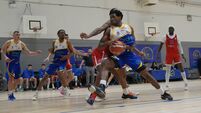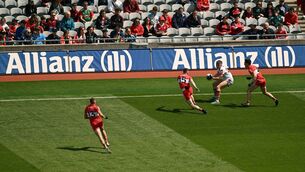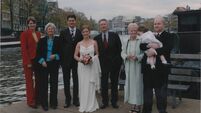Confusion around tackle guaranteed to spark mayhem
I witnessed the revolution at first hand. An ordinary footballer, I had the privilege of training under some first class managers. In that respect my CV is quite impressive as it includes Adrian McGuckin (11 MacRory Cup and four Hogan Cups), Brian McIver (All-Ireland club title with Ballinderry and league title with Donegal) and Charlie Sweeney (two Sigerson Cups).
In the 90s the aforementioned trio were among the best-informed managers in the game. And, like the vast bulk of their peers, they placed a huge emphasis on fitness and the basic skills. Tackling drills were extremely rare, but a glance at the honours won by those men proves their methods were highly effective. Work commitments forced me to quit playing in 1999 but I returned in 2003. A few years later ex-Tyrone midfielder Jody Gormley (former Antrim manager who led Abbey CBS to the Hogan title in 2006) was training us.
The first few training sessions were unforgettable. It was like entering a new world. For the first time I received detailed instruction on tackling. We were shown how to plant our feet for stability, how to stop an opponent, how to move when the opponent moved and how to force him onto his weaker foot. Night after night we did drills which focused on those techniques. Channels were set up where we tackled one-on-one, two-on-one, two-on-two, and three-on-three. We also did conditioning exercises which made us stronger for effective tackling.
If a typical training session lasted an hour, then at least one-third of the time was for tackling drills. The vast majority of Gaelic football teams now work along similar lines.
That just didn’t happen in the 90s, not at club, colleges, university, or county level. Watch any inter-county match from that era on TG4 and the contrast in the style of tackling is absolutely astonishing.
Some 20 years ago players were encouraged to spread their arms like someone pretending to be a ghost inside a sheet. The objective was to block the opponent, shepherd him to safety and dislodge the ball.
Nowadays, the tackle is much more robust. The objective is to stop the opponent with physical force without knocking him over. This is usually done with an explosive two-handed push that is backed up with a body-check.
By the letter of the law, this first point of contact is a foul, but almost never penalised. Having stopped the player, the next objective is to dispossess him.
The craftier defender will grab one of the forward’s arms, forcing him to hold the ball with just one hand. This makes it much easier to knock away. If the player in possession dithers, he will be swarmed or penalised for over-carrying.
The physical intensity of the modern tackle, coupled with the effectiveness of the mass defence, means it is more difficult to score.
Top quality forwards can be smothered. Last weekend the combined attacking talents of Paddy Bradley, Benny Coulter and Kieran Donaghy conjured up the sum total of 0-1. Coulter was the only one to score.
Teams have become adept at negating full-forward lines. Rather than waste possession by trying to pick out a star forward who is going to be surrounded, the prevailing tactic is to run in straight lines at the massed defence.
Half-backs are the new half-forwards and the onus is now on defenders and midfielders to take a score.
Therein lies the major problem facing referees. What constitutes a fair tackle? Evidently, there is widespread confusion. During the McKenna Cup, I watched two games (Tyrone v Antrim and Down v Armagh) where the referees gave huge latitude to the defender. Some of the tackles were more akin to what is witnessed during the Six Nations.
But I heard reports about the O’Byrne Cup semi-final between Dublin and Kildare where the referees sided with the player in possession and defenders were punished for the slightest discrepancy.
Not only is it now harder to score, the game is also much more difficult to referee. The tackle is a complete minefield. Squads are spending hours on the field perfecting proper tackling technique. They are also working exhaustively on the art of fouling without giving away a free-kick.
Judging by the massive interpretation disparity among referees, the same effort is not being made by the GAA to produce a uniform agreement of what represents a legal challenge.
As most teams are now defending with 12 men, the only way to break the cordon is to carry the ball into the maelstrom. Time and time again, referees will have to decide if the solo-runner was fouled. It is a marginal call.
Last year’s All-Ireland final was decided on one such incident. A different interpretation of the tackle could have yielded different results in last year’s Ulster semi-final between Donegal and Tyrone and the Leinster semi-final between Dublin and Kildare.
The gap between teams is growing smaller each year. One call can make all the difference.
While the pressure on referees is immense, there is almost zero consistency in their adjudication. Despite all the assessors and tutorials, the variance in competence and judgement is bewildering.
The early signs from this year are already extremely worrying.
Another season of media mayhem and mass controversy looks virtually guaranteed.
* p.heaney@irishnews.com










